How to Snorkel – A Beginner’s Guide
There are many fun activities that you can do at the beach, including snorkeling. It offers you the opportunity to see marine life up close and enjoy the tranquility of being out in the ocean. Although it might appear to be daunting, snorkeling is actually quite easy and not exactly dangerous.
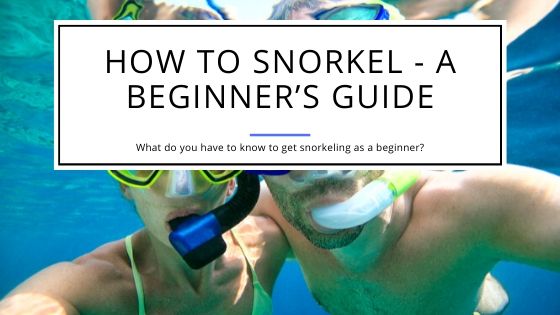
- What is Snorkeling?
- How Was Snorkeling Invented?
- What Equipment Do You Need To Snorkel?
- Should You Rent Or Buy Your Equipment?
- What Are The Basics In Maintaining Your Gear?
- Where Should You Practice and Learn?
- Do’s & Don’ts of Snorkeling
- How Good Of A Swimmer Do You Have To Be To Snorkel?
- How Can You Improve Your Breathing and Breath-Holding?
- Do You Have to Exercise and Build Up Stamina First?
- Can You Get Sunburned When Snorkeling?
- Final Thoughts
In fact, with a little practice, you can even explore deeper in the ocean rather than just having a look under the surface. We’re here to guide you through the basics of snorkeling so that your first time can be as enjoyable as possible.
What is Snorkeling?
Technically, snorkeling is defined as the activity of swimming in water with the help of snorkel gear such as a mask, snorkel tube and fins. This equipment lets you swim and breathe comfortably while your body and face are submerged in the water – Can You Snorkel Without knowing how to Swim?
Don’t confuse this with scuba diving where you’ll go at least a few meters deep in the water- when snorkeling, you’re restricted to the water surface as going deeper will fill your snorkel (breathing tube) with water.
How Was Snorkeling Invented?
The earliest versions of snorkeling can be traced back to the island of Crete in Greece in around 3000 BC. Ancient divers made use of hollow reeds the way a modern snorkel tube is used.
As time progressed, man’s interest in exploring the depths of the ocean led to the development of proper snorkel equipment. In around 900 BC, divers started using animal skins filled with air to increase the amount of time they could spend underwater. This was just the beginning.
Leonardo Da Vinci gave more to the world than just the Mona Lisa- he designed a range of apparatus ranging from basic tubes for surface breathing to complete dive suits! His sketches also showed some early designs for fins in the form of gloves with webbed fingers.
Modern technology has made snorkeling a more feasible activity for the masses. With the development of snorkel gear designed specifically to handle water pressure (without getting damaged or causing damage to the snorkeler), snorkelers are able to see underwater with more clarity and comfort. With the help of newer, more efficient equipment, even children can snorkel now.
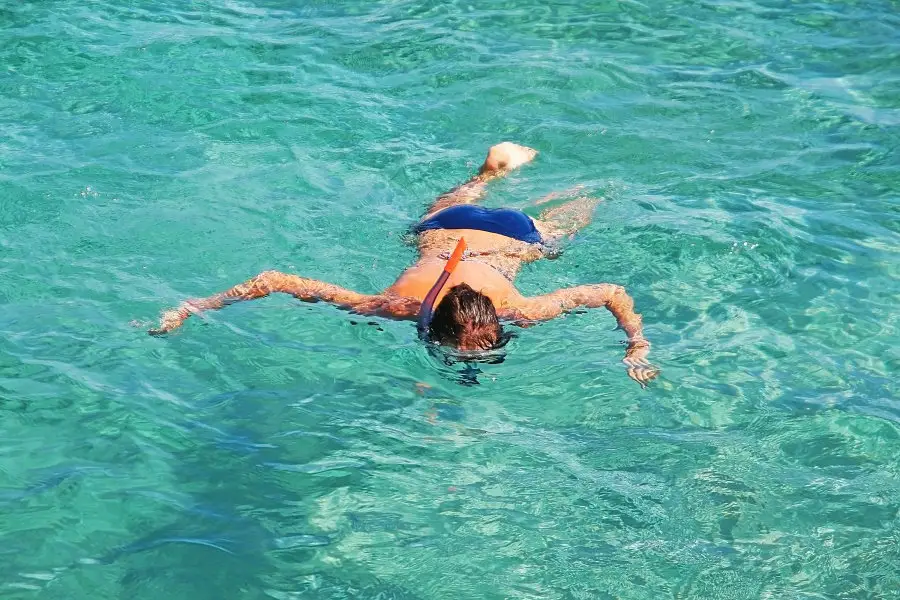
Full-face snorkeling mask reviews – How good is the Subea/Tribord Easybreath?
What Equipment Do You Need To Snorkel?
Snorkeling isn’t hard, but you need some essential items that will help you see underwater, help you breathe and let you explore the water comfortably. These include:
Mask and Snorkel
The snorkel mask is probably the most important item and will affect your entire snorkeling experience. Make sure that you choose the right size and test it out before getting the water. The standard test with snorkel masks is to hold one against your face and inhale through your nose- if the mask seals well and stays in place without you holding it, you’re good to go.
You’ll come across masks made of different materials and with different lenses (single or double pane). Don’t compromise on the quality since a low-grade mask will not only deteriorate faster, it will also be uncomfortable to wear and likely to leak.
Also, learn about basic techniques such as defogging your mask and cleaning it before you start snorkeling.
Now, for the snorkel tube- here too you will find different varieties such as:
- The classic snorkel that allows water to enter from both ends and if any water gets in the tube, you need to sharply exhale to release it (the best choice for beginners)
- The dry snorkel that doesn’t allow any water to enter (not ideal for beginners)
- The semi-dry snorkel which is a cross between the two
The Full Face Snorkel Mask
There are some full-face snorkel masks that have gained some interest among snorkelers – the Wildhorn Outfitters Seaview 180 Degree V2 for example. These combine the mask and snorkel into one contraption that covers your entire face rather than just till your nose (e.g. the Ocean Reef Aria Full Face Snorkel Mask).
The huge advantage of those full face masks, for beginners and avid snorkelers, is that you can breathe through your mouth or nose. With a traditional snorkel, you have to bite down on the mouthpiece while these types of devices don’t require that. This makes it a lot more convenient and relaxing to snorkel – Finding the Best Full-Face Snorkeling Mask for Children
However, they are definitely not the best choice for beginners since they tend to be more expensive. For someone who is snorkeling for the first time, the traditional mask and snorkel is the best combo as it is cheaper and easily available anywhere.
Fins
While some snorkelers prefer not to use fins, they can be quite handy since they’ll help you move through the water faster and with greater control. Choose fins that are comfortable (not too tight, not too loose).
You will also get the choice between a single and a split fin. Split fins are more comfortable for newbies since they’re more flexible but single fins allow for greater speed. Just remember to be careful that your fins don’t come in contact with any corals or drag through the sand underwater.
If you are snorkeling regularly then consider picking specific snorkel fins. These are shorter than scuba diving fins which reduces the thrust you can generate but make it a lot easier to walk into the water and move around on land.
Wetsuit/Rash Guard
If you plan on snorkeling for a long period of time, it is best to put on a rash guard or wetsuit trunks to avoid serious sunburn. Use plenty of eco-friendly sunscreens so that you don’t suffer later.
Snorkel Vest/Belt
Since snorkeling is an activity for both swimmers and non-swimmers, a snorkel vest (or belt) is useful if you don’t know how to swim. It will help you stay afloat, even if you’re just staying in one place waiting for your boat or something. It also makes beginners feel safer and more comfortable if it’s their first time in the water.
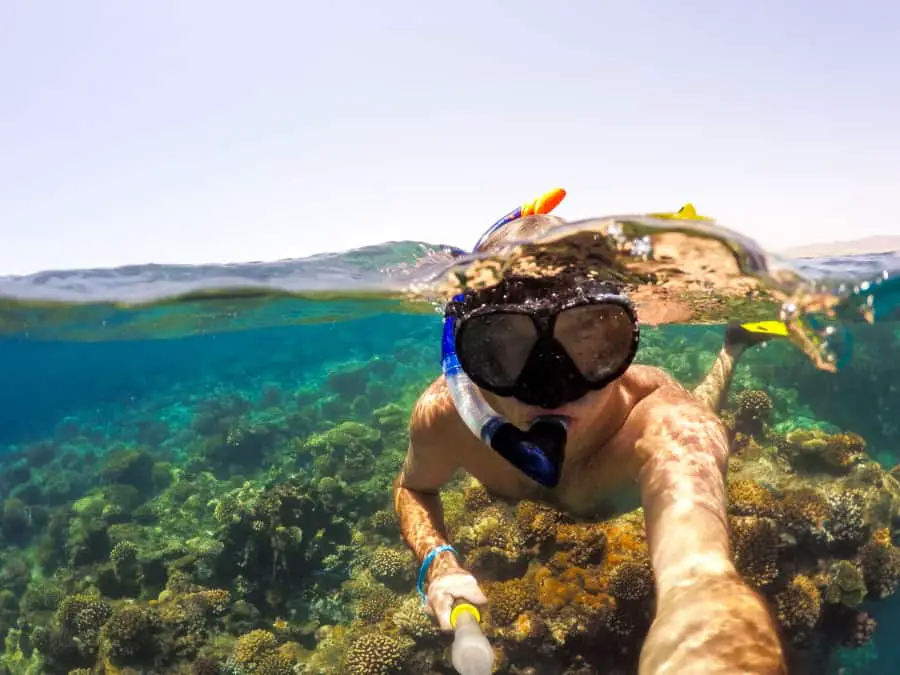
Should You Rent Or Buy Your Equipment?
This depends on whether you’re planning to snorkel on a vacation at the beach or making it into a hobby. If, say, you plan on snorkeling once a year, it is cheaper to rent the equipment from a local dive shop or snorkel tour. If you plan on snorkeling frequently, it is better to buy the equipment. It will seem like a larger investment initially, but it will be economical in the long run.
Buying your equipment also means that you can get items that are the perfect fit for you, especially if you have a face that requires a specific type of mask.
Some snorkelers choose to do both- they’ll rent some of their gear and buy others. Generally, it’s a good idea to have your own mask and tube and you can rent the fins and snorkel vest/belt.
What Are The Basics In Maintaining Your Gear?
In order to keep your gear in top shape and prevent your mask (How To Prevent Your Snorkel Mask From Getting Fogged Up) from becoming loose, you have to follow some basic maintenance steps.
Before You Snorkel
Before you snorkel, you need to defog your mask- rub it with a little toothpaste and rinse it with soap and water (ideally, repeat this a few times to completely defog your mask). Once you’ve done this, you can put on all your gear except the fins.
Put your fins on either right when you’re at the edge of the water or about to jump off your boat. This will help you avoid tripping over them and hurting yourself or breaking the fins.
Use shorter snorkel fins if you enter the water from shore and have to wade through water. They make it easier to walk in the water until you reach a depth that allows you to float.
During and After You Have Snorkeled
If your mask fogs up in the water, you can use a little bit of saliva to clear it up. If it fills up with water, tilt your head up, press the top of your mask against your forehead and exhale sharply to dispel the water.
When you’re out of the water, don’t push your mask up on your forehead. It may accidentally slip off or get stuck somewhere hurting you and damaging your gear in the process. The best thing to do is hang it around your neck until you can take it off. Remove your fins before you walk on the beach to avoid damaging them or tripping over them.
How to Store It
Storing your gear properly is vital. You don’t want it to get damaged, simply because you didn’t know how to store it properly. Once you remove all your gear after your dive, rinse it thoroughly with soap and water to get rid of any traces of the salty water or dirt.
Let everything dry completely (you may use a soft cloth for this) and place it in an airtight space, free of humidity. If you want to prevent your mask screen from getting scratched, you can place it in a cloth-lined box.
How can you prevent Mask Squeeze when diving underwater while snorkeling?
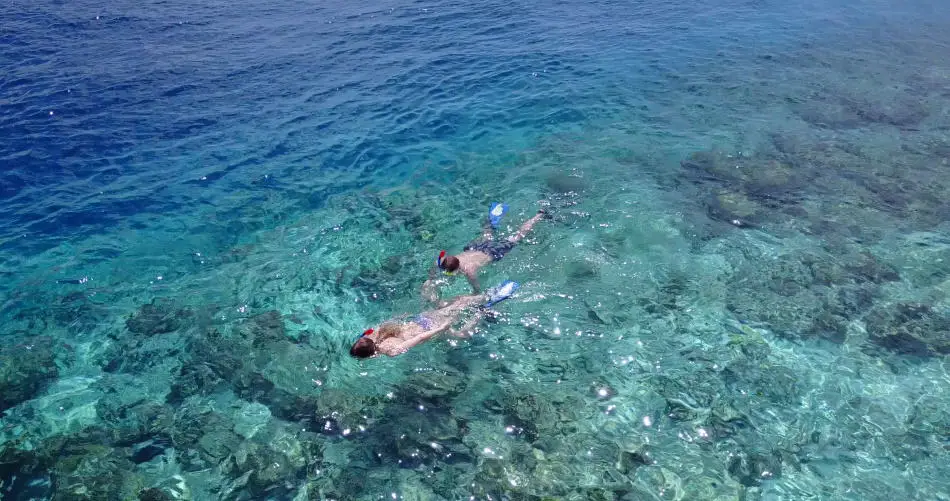
Where Should You Practice and Learn?
Should you start snorkel-practice in a pool, a lake or just start with the ocean? You can start pretty much anywhere, but there are some conditions that are more preferable than others:
In a Pool
Ideally, you should practice your snorkeling in a swimming pool to familiarize yourself with the gear. If your gear doesn’t fit right or you panic in the water, getting out will be easier.
In a Lake
If you have a shallow lake in the area that is frequented by swimmers, you can treat it like a large swimming pool and practice there as well.
In the Ocean
Many people develop an interest in snorkeling when they’re on holiday by the coast. If so, it’s kind of pointless to waste an entire day in a pool rather than going into the ocean. In this case, you just need to be careful where you snorkel.
Salty seawater will help you float anyway but look for a location where the water is calm without any harsh waves. Stay towards the shallow end, especially if you’re skeptical about the water current.
Wade into the water until it reaches your chest and put on your mask and fins (and floats if you’re using any). Don’t try to go too fast. Snorkeling is more enjoyable if you go slow and have the time to appreciate everything around you and under the water surface.
What to Look Out For
Regardless of where you are practicing, the biggest problem for most people is using their snorkel, especially if a little water gets in. The majority of snorkel tubes have a purge valve- if you can’t get rid of the water by exhaling, press the valve and the water will escape.
Try to breathe normally because holding your breath or breathing too rapidly can reduce the amount of oxygen you get. This can lead to panic attacks or suffocation and is very dangerous, especially if you find yourself unable to get back to the shore.
Do’s & Don’ts of Snorkeling
Do Not Snorkel By Yourself
If you’re new to snorkeling, it’s a good idea to have a snorkeling buddy who is relatively experienced. Snorkeling isn’t particularly dangerous, but when you’re out in the ocean, anything can happen.
There may be strong water currents, strange sea creatures or you might even have a problem with your gear. In this case, your snorkel partner can be very useful.
Do Not Touch Anything
It’s best for you and the ecosystem to not touch anything in the water. Some people get too excited when they get in the water.
They may be tempted to touch a beautiful-looking piece of coral or a particularly adorable fish. Regardless of how adorable something seems, don’t touch it. Some sea creatures might get aggressive and some corals can become severely damaged by the human touch.
Keep Calm
As long as you’re in the water, don’t panic. If you have a sudden panic attack (maybe due to equipment malfunction, improper breathing technique, etc.), try to float on your back with the support of your float vest and call out to your snorkel buddy. Once they reach you, they’ll help you calm and return to the shore.
Get Oriented and Watch Your Surroundings
Get well-acquainted with the surrounding before getting in the water. Observe other snorkelers and swimmers, find out about the water currents and any potential points where you are likely to come in contact with sharp rocks. Find a safe entry point with calm waters and no jagged rocks.
How to find the best snorkeling vests – Buying Guide and reviews
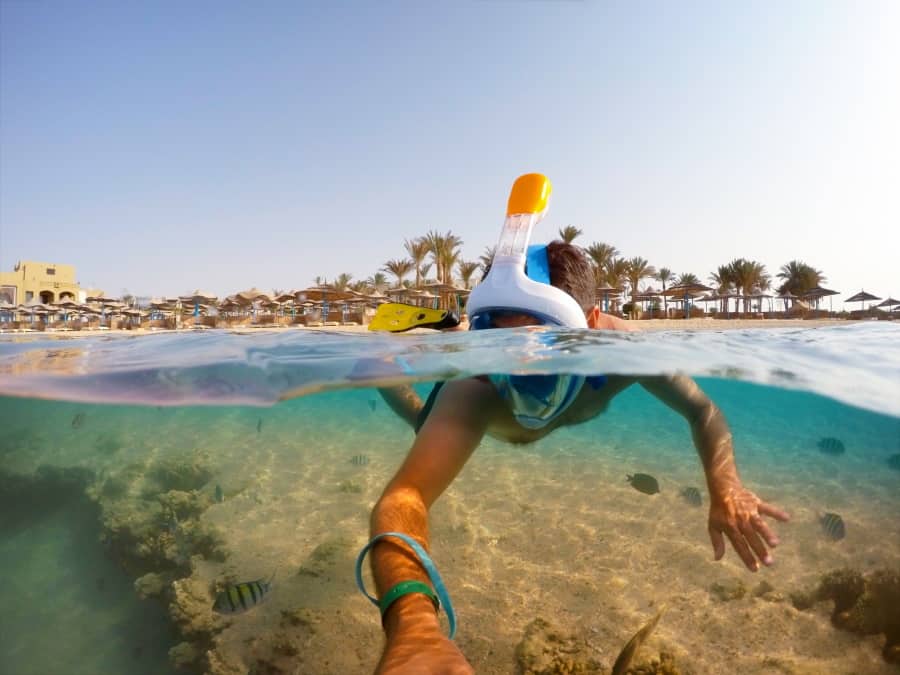
How Good Of A Swimmer Do You Have To Be To Snorkel?
If you’re seriously interested in snorkeling and intend to go further into the water rather than just wading near the coast (or near your dive boat), you need to be a decent swimmer. Even if you’re only good at freestyle, it’ll help you a lot since the kicking technique used there will help you as you snorkel.
If you’re a good swimmer, you won’t even need to don a snorkel vest (or belt) and you’ll be able to swim more freely. You’ll also be able to go a little deeper and see some corals and marine life up close.
Swimming with Fins
Even if you’re a decent swimmer, swimming with fins on is a whole different ball game. They add drag and weight and if you’re not careful, you might cramp a muscle trying to swim forward with your fins.
If you own a pair of fins, practice swimming some laps with them at your local swimming pool. Over time, you will become more comfortable with your fins and you’ll be able to enjoy yourself more.
How Can You Improve Your Breathing and Breath-Holding?
Amateur snorkelers generally stay at the water surface and look down to see the marine life. In this case, take long, deep breaths to keep your heart rate down and conserve energy.
Advanced snorkelers may occasionally hold their breath and dive down for a closer look at the corals and marine life. In order to spend more time underwater, you need to train yourself to improve your breath-holding capacity (this will also make you a more efficient swimmer).
If you want to see as much as you can in a single breath, here is what you need to do:
Relax and spend a little time at the surface to conserve your energy. Don’t move around too much. Next, breathe deeply to completely fill and empty out your lungs (NOT the same as hyperventilation). Then, take a very deep breath and begin your descent:
Bend yourself at a 90-degree angle from your waist, so that your torso is submerged in the water vertically. Raise your legs up so that they are also vertical and use the weight of your legs to push you deeper in the water- this will help you conserve more energy. Once you’re in, use your fins to push you forward.
Stay calm while you’re underwater as this will also help you increase your time for holding your breath underwater. Swim slowly and efficiently so that every stroke thrusts you forward. Don’t try to stay underwater for too long the first time. Resurface well before you run out of breath and gradually increase the time spent underwater every time. If you keep tabs on the time spent underwater, you’ll notice a gradual increase over time.
Do You Have to Exercise and Build Up Stamina First?
You might find yourself in a situation where you’ve never snorkeled before, but you intend to on an upcoming holiday. If you want to spend more time in the water, you need to build up your stamina.
Your muscles need to allow your body the strength to stay in the water and move around without cramping. You also need to be able to breathe comfortably and not start panting after just a few minutes in the water.
If you’re going to snorkel over a day or two (or more), start off slow and even after one day, you’ll notice that you can move around a bit more easily and that you don’t get tired as quickly.
Basically, if you just intend to wade by the shore, you don’t need to build stamina, but if you are physically fit, you’ll be able to swim out further and see much more marine life (especially those creatures that don’t come close to the coast).
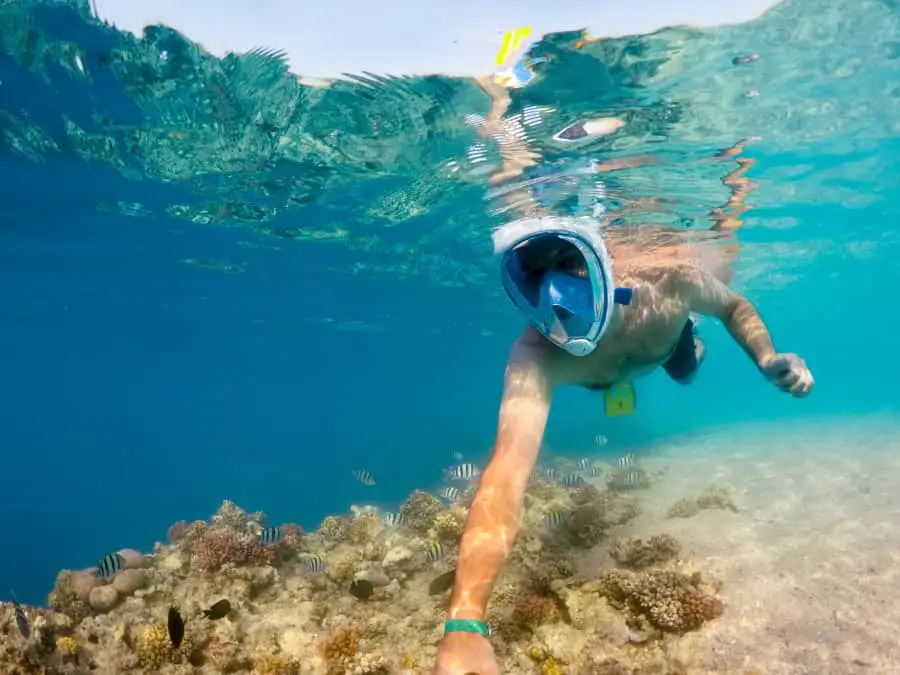
Can You Get Sunburned When Snorkeling?
Snorkelers are more prone to getting sunburned than the people on the land. This is due to a number of reasons:
- Apart from the sun directly coming in contact with your skin, it is also reflected back by the water and may reach under your eyes, arms, etc.
- The surface of the sea has magnifying properties that can magnify UV rays that can reach up to 25 centimeters in the water. This can make your skin itch once you’re out of the water.
- There is a chance that you might not feel the UV rays in the water and suffer from severe sunburn later on.
The best thing is to wear eco-friendly sun-block (that won’t contaminate the water). If the sun’s rays are particularly harsh and strong, you may need to wear a thin t-shirt or a wet suit to keep your skin from getting red and burnt.
Final Thoughts
Snorkeling is a great way to de-stress and explore the ocean. You just need to take care of a few things first including:
- Having the right gear
- Knowing how to use your gear
- Knowing about the water conditions and any potential dangers to look out for
- Have a snorkel partner/buddy
As long as you’re properly equipped and you stay calm, your snorkeling experience will be a great one.
